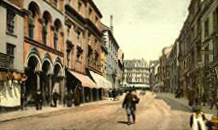
Discover Your Ancestors
Two critically acclaimed publications are available to family history researchers - the annual print magazine, Discover Your Ancestors, and the monthly online magazine, Discover Your Ancestors Periodical. Click here to subscribe.Northamptonshire

In the 1st century BC, most of what later became Northamptonshire became part of the territory of the Catuvellauni, a Belgic tribe, conquered in turn by the Romans in 43 AD. The Roman road of Watling Street passed through the county, and an important Roman settlement, Lactodorum, stood on the site of modern-day Towcester. After the Romans left, the area eventually became part of the Anglo-Saxon kingdom of Mercia, and Northampton functioned as an administrative centre. From about 889 the area was conquered by the Danes, until being recaptured by the English under the Wessex king Edward the Elder in 917. Northamptonshire was conquered again in 940, this time by the Vikings of York.
In 1460, during the Wars of the Roses, the Battle of Northampton took place and King Henry VI was captured. The now-ruined Fotheringhay Castle was used to imprison Mary, Queen of Scots, before her execution.
George Washington, the first President of the United States of America, was born into the Washington family who had migrated to America from Northamptonshire in 1656. George Washington’s 5x great-grandfather, Lawrence Washington, was Mayor of Northampton on several occasions.
During the English Civil War, Northamptonshire strongly supported the Parliamentarian cause, and the Royalist forces suffered a crushing defeat at the Battle of Naseby in 1645 in the north of the county. King Charles I was imprisoned at Holdenby House in 1647.
In the 18th and 19th centuries, parts of Northamptonshire and the surrounding area became industrialised. The local specialisation was already shoemaking and the leather industry. Northamptonshire made boots for Oliver Cromwell’s New Model Army, and the making of army boots continued to be an important feature of the economy until the 20th century, as well as boots and shoes of other kinds. By the end of the 19th century it was probably the boot- and shoe-making capital of the world.
In the 17th century the weaving industry declined in the Northampton area, but flourished around Kettering. Other early industries were charcoal-burning, brick and tile manufacture and brewing. The industries of whipmaking, pipe-making, silk-weaving and paper-making were introduced in the 17th and 18th centuries.
The iron-mines and stone-quarries of Northamptonshire were worked in Roman times, but the former were entirely neglected from the Plantagenet period until their rediscovery in 1850, while the two most famous quarries, those of Barnack and Stanion, were exhausted in the 16th century. During the 1930s, the town of Corby was established as a major centre of the steel industry. Much of Northamptonshire nevertheless remains largely rural.
The Soke of Peterborough was historically associated with and considered part of Northamptonshire. However, Peterborough had its own Quarter Sessions and, later, county council, and in 1965 it was merged with the neighbouring county of Huntingdonshire; in 1972 the city became a district of Cambridgeshire.
Exclusive census analysis from data at TheGenealogist reveals that common surnames in Northamptonshire in the 19th century included Ward, Adams, Clarke, Cox, Chapman and Allen. In 1841, other common Green, Webb and Dunkley; plus Harris, Knight and Bailey in 1911. In that timespan the county’s population rose from 194,000 to 364,000.
Northamptonshire Records Online
Leading data website TheGenealogist.co.uk has a wealth of records for Northamptonshire. Here is a quick run-down of what you can find (in addition to national collections):
- Trade directories: two directories, for 1850 and 1898.
- Census records: Northamptonshire records for every census from 1841 to 1911.
- Parish registers for nearly 20 parishes (see www.thegenealogist.co.uk/coverage/parish-records/northamptonshire).
- Nonconformist registers: Nonconformist chapels and meeting houses across Northamptonshire are covered in the site’s collections.
- Land owners: the site’s huge collection of tithe commutation records includes Northants, along with tithe maps; plus an 1873 survey of Welsh and English landowners includes the region.
- Wills: Many people from Northants can be found in Prerogative Court of Canterbury PCC) Wills 1384-1858, and the site has a calendar of wills from the county, 1510-1652.
- Poll books for 1702-1831.
- Medieval visitations 1564 and 1618-19.